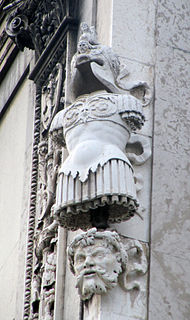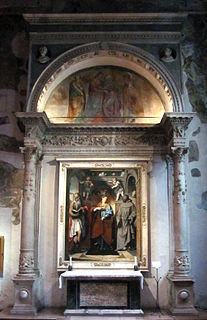
Giacinto Fabbroni (active mid-18th century) was an Italian painter, born in Prato, but mainly active in Impruneta and Florence. [1] He painted an altarpiece of La Concezione for one of the chapels the church of San Gaetano in Florence. [2]

Giacinto Fabbroni (active mid-18th century) was an Italian painter, born in Prato, but mainly active in Impruneta and Florence. [1] He painted an altarpiece of La Concezione for one of the chapels the church of San Gaetano in Florence. [2]

Pietro da Cortona was an Italian Baroque painter and architect. Along with his contemporaries and rivals Gian Lorenzo Bernini and Francesco Borromini, he was one of the key figures in the emergence of Roman Baroque architecture. He was also an important designer of interior decorations.

Giovanni Battista (Giambattista) Foggini was an Italian sculptor active in Florence, renowned mainly for small bronze statuary.

Benedetto Briosco (c.1460–c.1517) was an Italian Renaissance sculptor and architect, active in Lombardy.

Vincenzo Dandini (1607–1675) was an Italian painter of the Baroque period, active mainly in Florence. He was a pupil of his brother, Cesare Dandini in Florence, then he moved to Rome and worked in the studio of Pietro da Cortona. Among his pupils were Giovanni Battista Marmi and Antonio Domenico Gabbiani. His nephew Pietro and his two children, Ottaviano and Vincezo the younger, also worked as painters in his studio.

Niccolò di Pietro Gerini was an Italian painter of the late Gothic period, active mainly in his native Florence although he also carried out commissions in Pisa and Prato. He was not an innovative painter but relied on traditional compositions in which he placed his figures in a stiff and dramatic movement.

Francesco Londonio was an Italian painter, engraver, and scenographer, active mainly in Milan in a late-Baroque or Rococo style.
Pietro Parenzo was a mayor of the Italian Comune of Orvieto during the 12th century. He was assassinated in 1199 by the adherents of Catharism and became honored as a saint and wonderworker after his death. He is the patron saint of the city of Orvieto.
Giuseppe Giosafatti (1643–1733) was an Italian architect and sculptor, mainly active in the city of Ascoli Piceno.

Gasparo Cairano, also known as Gasparo da Cairano, de Cayrano, da Milano, Coirano, and other variations, was an Italian sculptor of the Renaissance.

Biagio Martini was an Italian painter, active mainly in Parma in a Neoclassical style.

Luca Cancellari is a Byzantine icon painter posited in some modern Greek encyclopaedias to have lived during the 12th century in Constantinople, where he painted some of the best icons of Virgin Mary. These works ascribe him the creation of icons like the Madonna Nicopeia in St Mark's Basilica, that ended up in Venice after the conquest of Constantinople by the Crusaders in 1204, the Madonna di San Luca in the namesake Sanctuary, transferred in Bologna in 1160 and bearing the inscription Opus Lucae Cancellari, or as read by Antonio Masini (1599-1691) Cancellarii, the Madonna Salus Populi Romani in the Basilica di Santa Maria Maggiore in Rome and other with Greek inscriptions of that period.
Alessandro Bernabei (1580–1630) was an Italian painter of the late-Renaissance or Mannerist period, active in his native Parma. Two brothers were painters, his twin, Francesco, and his elder brother Pier Antonio Bernabei, also called Della Casa or Maccabeo.

Stefano Gherardini (1695-1755) was an Italian painter, prolific in painting genre scenes or bambocciate.
Giacomo Dondoli was an Italian painter active in Verona. He studied in Verona initially under Giovanni Battista Zannoni, then under Cavalier Coppa, and then Pietro Ricchi in Trento. He painted for Charles I, Duke of Mantua. He mainly painted sacred subjects including a San Carlo for the church of the Ghiara in Verona; a Last Supper for San Fermo; a Death of Sant'Alessio for the church of the same name. He painted Nero watching Rome Burn and Story of Jacob. He was active in Verona circa 1717. His wife Caterina was also a painter.
Gentile Zanardi was an Italian painter, active in the Baroque period in Bologna.
Celso Zani, O.F.M., also Giuliano Zani was a Roman Catholic prelate who served as Bishop of Città della Pieve (1625–1629).

The Ark of Sant'Apollonio is a funerary monument in marble by Gasparo Cairano. Dated between 1508 and 1510, it is located in the third chapel on the right of the southern nave of the New Cathedral, Brescia.

The Ark of San Tiziano is a marble tomb attributed to the Sanmicheli studio. Finished in 1505, it is located in the Church of the Saints Cosma and Damiano in Brescia, in the chapel dedicated to these saints.

The Altar of San Girolamo is a sculptural complex in marble, around 780×450×80cm in dimension, designed and constructed by Gasparo Cairano and Antonio Medaglia, and situated within the Church of St Francis of Assisi in Brescia, Italy. Dated between 1506–1510, it is located in the first chapel on the right side of the nave.

Madonna of the Rose is a 1530 oil on panel painting by Parmigianino, now in the Gemäldegalerie in Dresden.